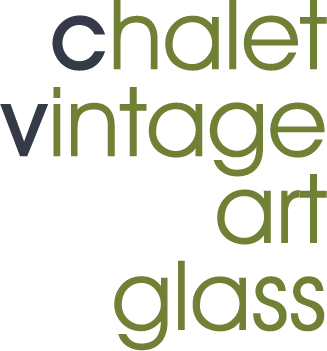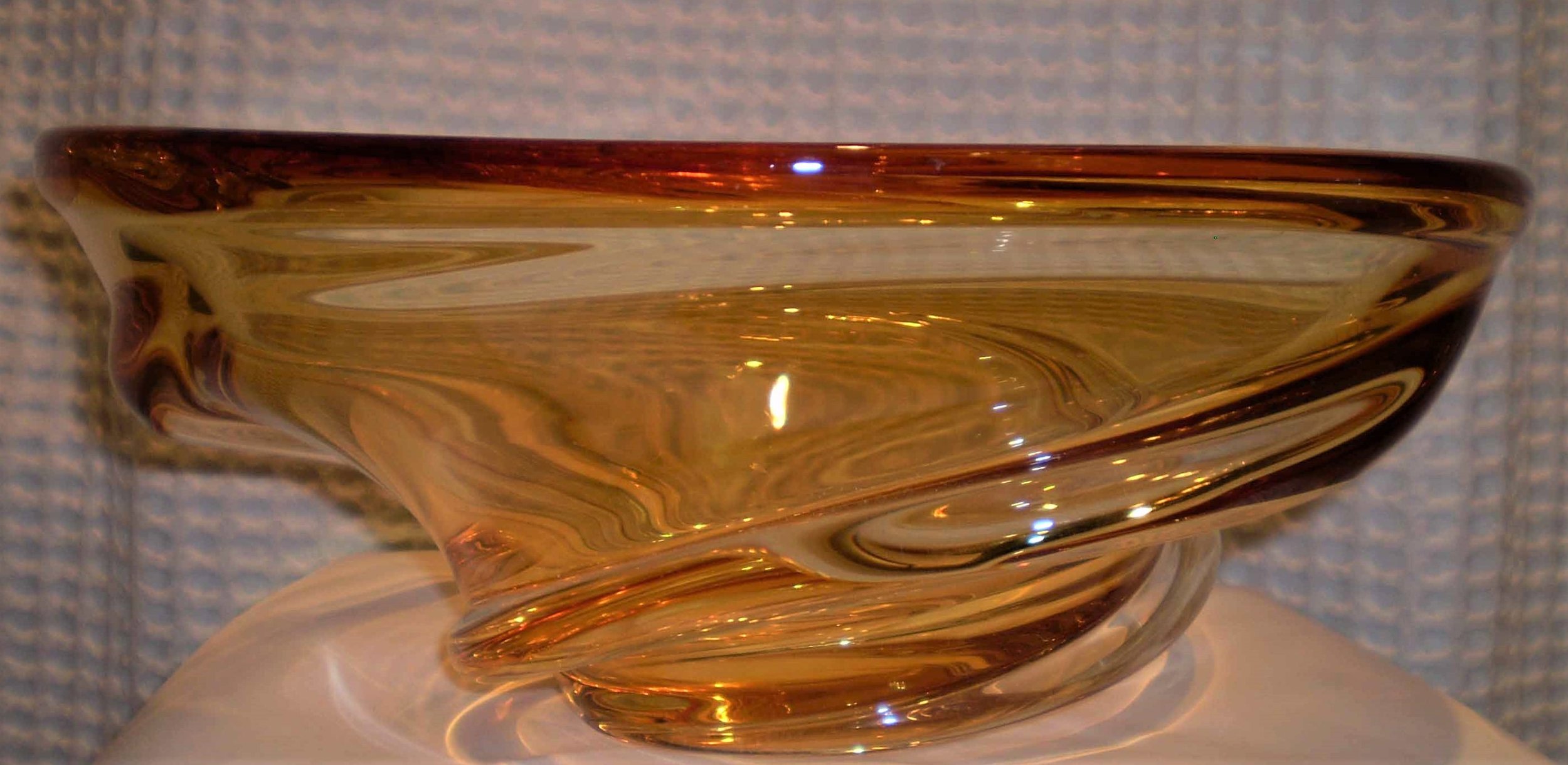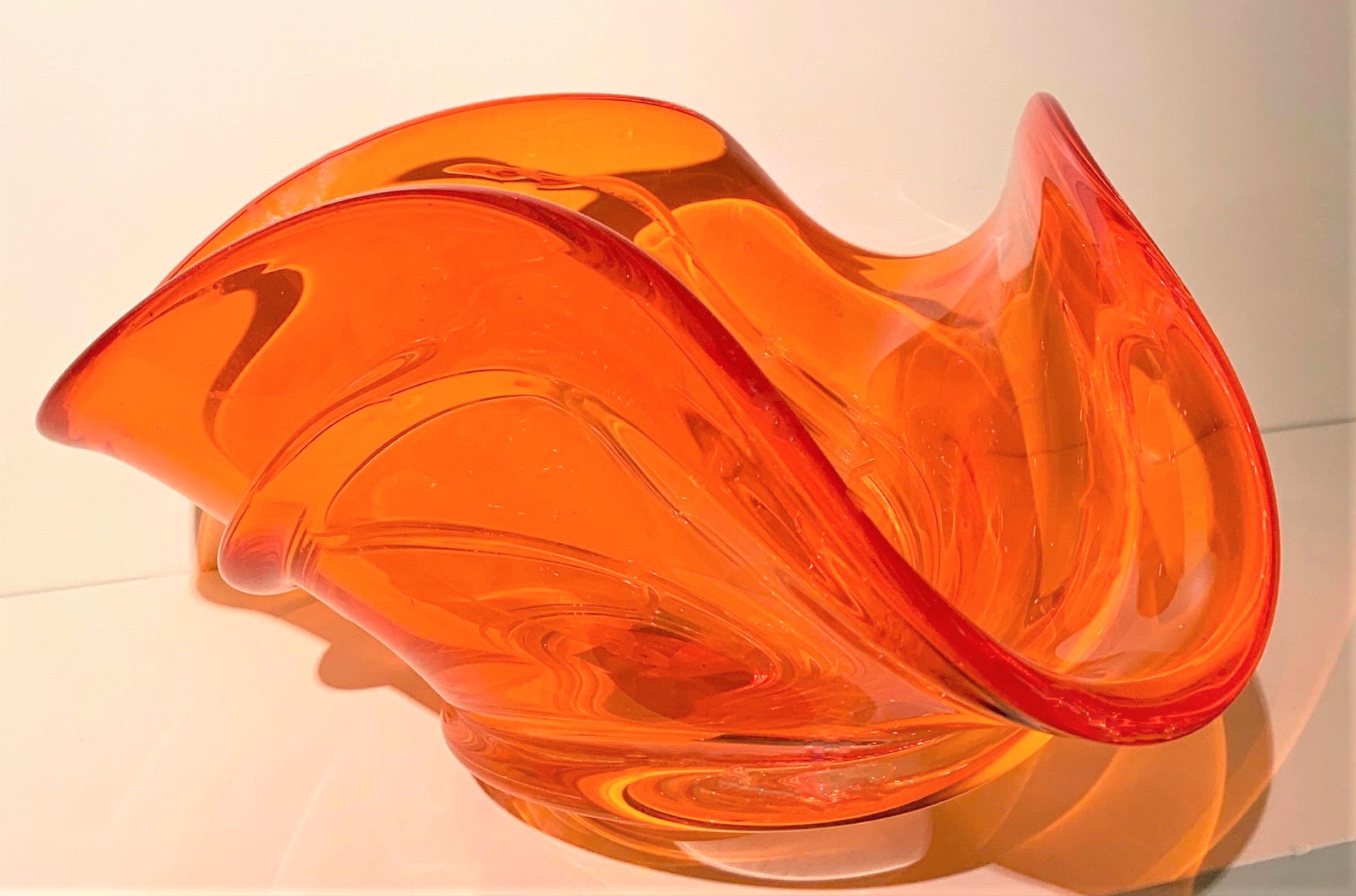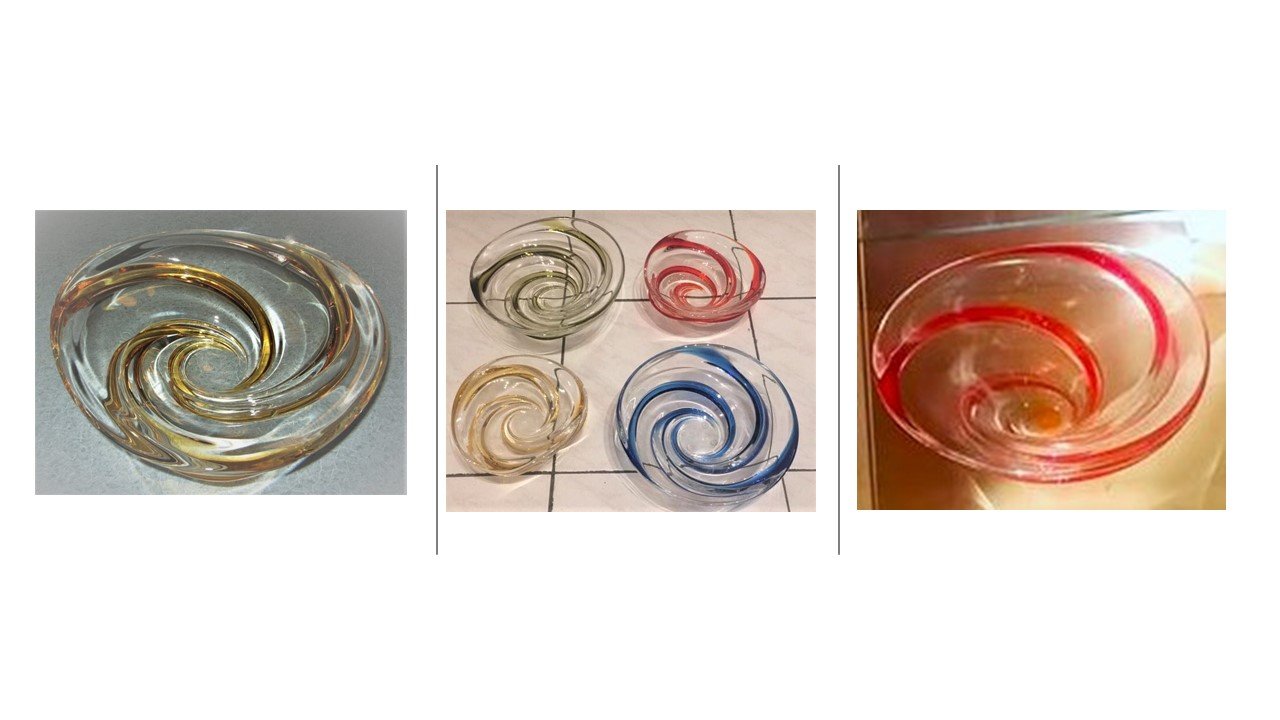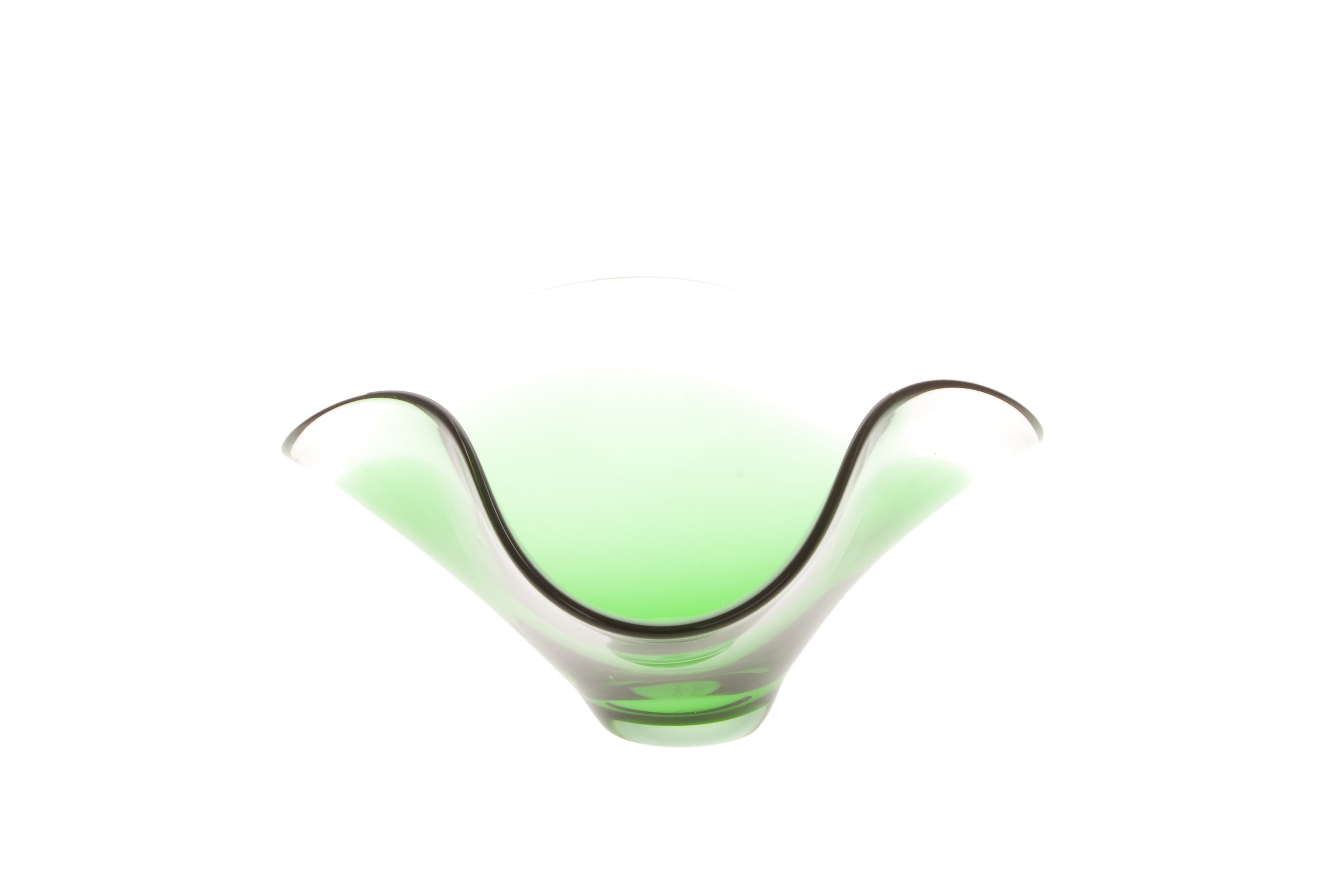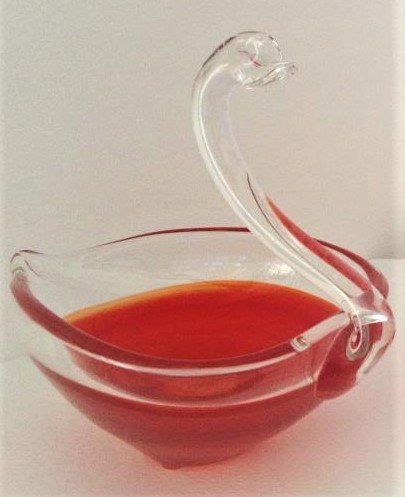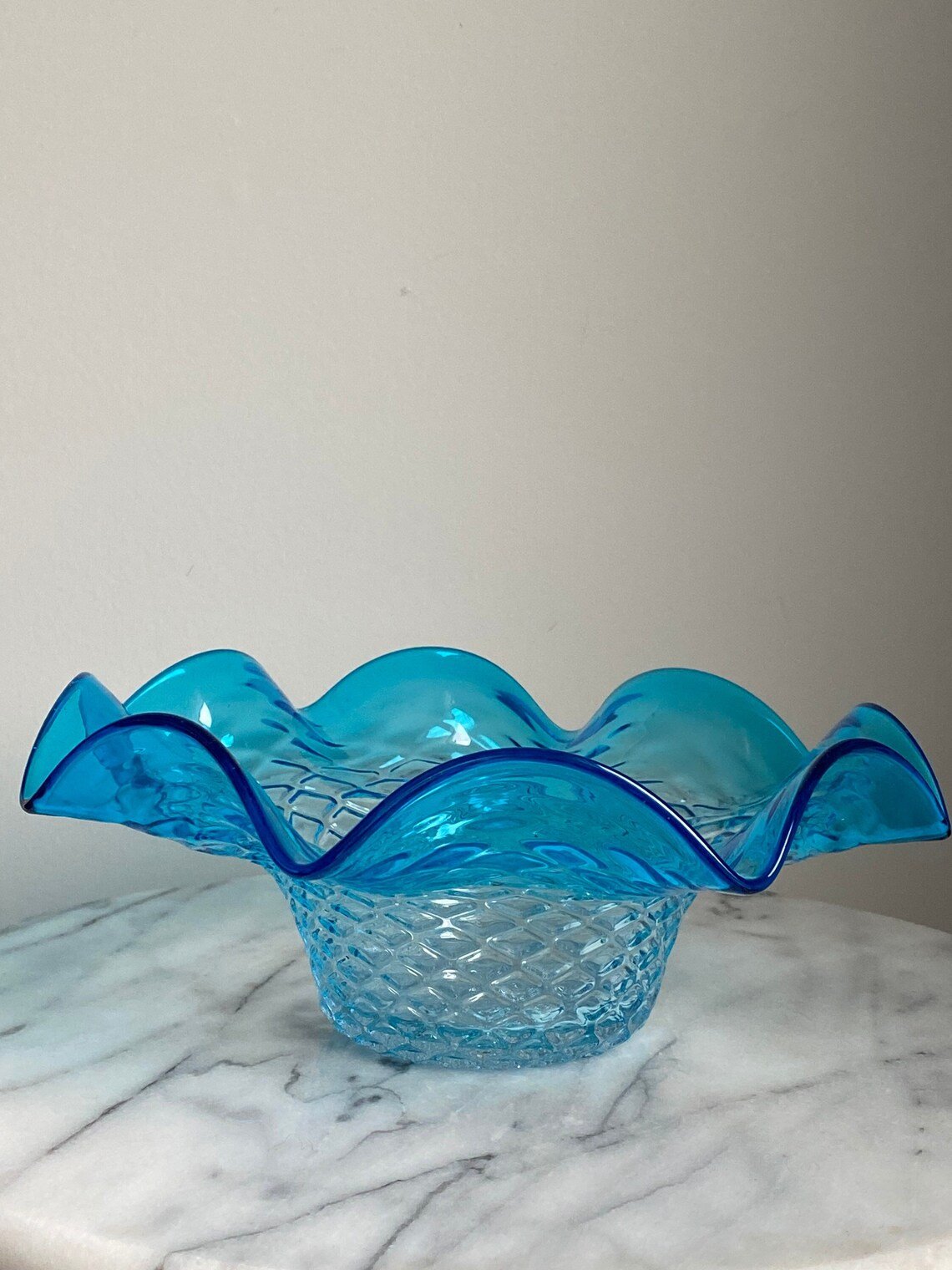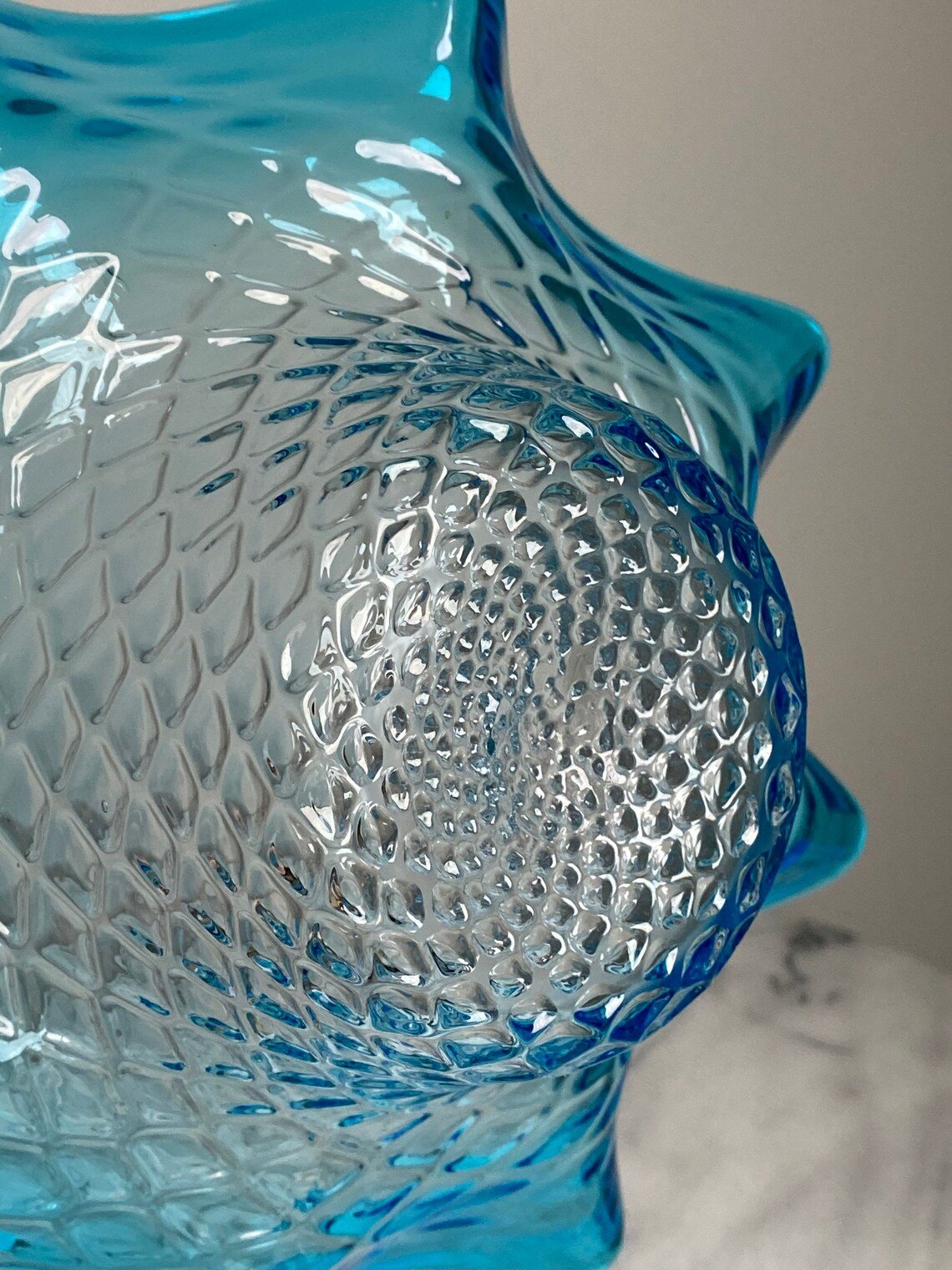The Chalet Bowls
To kick off this article, here is a Chalet riddle for you: When is a Chalet bowl not a Chalet bowl? When it’s a Chalet ashtray!
The Chalet bowl form is a round dish (typically) without indented “butt rests” for cigarettes or cigars on its rim. The rim is smooth and continuous. Chalet bowls may be hand blown (as are the 2 directly below) or hand molded (shown later).
In the photograph above, an ashtray is on left and a bowl is on right.
Still an ashtray! A scalloped rim and crystal ruffle may enhance the design but the function remains the same – this piece was created for smokers. No matter how elaborate the piece may be, if it has an indented rim as shown in the top view on the right, it is not a bowl or candy dish.
The Chalet bowl form can be a simple functional piece or a more elaborate creation with uplifted “prongs, spikes and fingers.” It can have a flat base or a pedestal base. Many bowls are production pieces but others that have been found are definitely rare. We even have seen a handful of “one-of-a-kind.” Styling in the Chalet bowl forms varies from heavy leaded crystal forms to much thinner (although still sommerso) modern looking styles. As well, there are two very Murano design-influenced “bird bowls” and there are bowls from the four hand molded lines.
Starting with the earliest known style in the heavy hand-blown line:
This bowl, P 45, was featured in 1962 on the earliest Chalet catalog sheet which is shown directly below.
P 45 is top row and second from left. Etched ”Chalet Canada”, This bowl is from the collection of the Zhao family.
A stunner in blue from the collection of 50 Shades member Daniel Lynch.
I do not believe that P 45 went very far forward into later years’ production as we see so very few of them. I also think that their scarcity may be further explained by it being prone to breakage as this form is not only large but very awkward.
This oft seen style of bowl has the same “tornado” swirl base as the vases and candleholders.
Top left bowl from the collection of 50 Shades member Ken Brewer. Bottom right photograph of base of the bowl shown below is from the collection of Deborah Patterson.
Showcased pieces from the collection of Deborah Patterson.
The “tornado” bowl has been found in 8, 10, 12, 14 and 16-inch diameters as well as in all the colours of the Chalet palette.
From the collections of four “50 Shaders”. Top left piece is again the one from my personal collection while bowl at top right is the one from Ken Brewer’s collection. They are a good illustration of although the same form and colour, there are obvious variations in shade, size, and shaping. Ken’s piece has a much more elevated base. The large orange bowl at bottom left is from the collection of Nicloe Giroux-LaPlante and bowl on bottom right is owned by Jo Highland.
50 Shades group member Erin Kinder holds a huge 14” in diameter bowl.
This massive bowl with a 16” diameter weighed over 20 lbs. Shipping cost over 10 years ago from Kingston, Ontario to an art gallery in Calgary, Alberta was almost $100.00. An easy one to wrap but finding a box strong enough to ship it there safely was not easy!
A different rim styling but same swirl base design.
This style is much more common in the “ribbon” bowls. It is exceedingly rare in solid colours.
We have found Chalet “ribbon” bowls in two typical styles. – with a dipping, fluted rim, and another with a smooth, level rim.
Although the solid-coloured piece shown directly above is quite rare, the “fluted” rim “ribbon” bowl is quite common. Note that this style, production #224, also exhibits the crystal swirl base.
It was also done in all the colours common to Chalet. This olive bowl is from the collection of 50 Shades member Nick Mucciante.
And lastly, a unique bowl of this style:
To date, this is the only multi-coloured ribbon bowl that we have seen. This special piece from the collection of 50 Shades member Bob Burgess.
The second style - production #223. With a smooth, level rim. Also was produced in a variety of colours and different dimensions.
Bowl on right from the collection of 50 Shades member Troy Spielman.
Sleek angular style in the most glorious colour and colour placement.
The “fingertip” bowl is rare and highly collectible. It is not a traditional round shape as clearly its design features exaggerate a strict circle form.
Done in both solids and 2-tones. The bowls at the top and bottom right are from the collection of 50 Shades member Cindy Bishop-Laughlin.
This gorgeous pair from the amazing collection of 50 Shades member Troy Danby.
A very much one-of-a-kind “fingertip.” I found this bowl right in Cornwall. It was in pristine condition – a miracle!
The cranberry in crystal bowls are large and heavy. This one has a diameter of 14”. It is not listed on the one inventory page for this line that we have.
Very, very rare. Was featured at the 2010 Chalet exhibit in Cornwall. Now in the collection of 50 Shades group member Kathi Norton.
Exceedingly rare. Another “Never say Never” bowl.
The following four bowls are vastly different in styling and colour placement from any of those shown above.
The traditional round bowl shape has once again been altered. In these bowls, it has been “folded”. These bowls are also very saturated in colour.
Production #199.
From the collection of 50 Shades member Benjamin Gregoire.
From the collection of 50 Shades member Iam Marc Lindner.
This style is also Chalet! This bowl is less heavy than the ones directly preceding. The rim is much thinner and the striking and precise colour placement and saturation continues all through the elevated flat base.
The red bowl at left is from the collection of 50 Shader Bob Burgess.
This is another differently styled bowl from this line. It is much smaller and lighter.
A larger version. Some variation in form and colour placement as well.
Glorious saturated colour! From the “red hot” collection of collector Wallace Addison White.
In the 1960’s and 1970’s pieces of Chalet were frequently given as awards, rewards, trophies, and commemorative gifts. Often, they were common production pieces (like the cranberry apples) but sometimes, they were special orders with engraving done right at the Chalet factory.
This unique bowl set is not only an excellent example of this but takes us back in place and time.
The base engraving on these is “Grace Plastics, June 3, 1967.” I checked with Don Smith (the curator of the Cornwall Community Museum) to see if Grace Plastics was a local business. It most certainly was – a large and long-standing industry in the city. The year is significant as well – Canada’s centennial.
Chalet also produced pieces for religious purposes.
This complete Eucharist set is from the collection of Paolo De Marchi. The little bowl (right foreground) was used to hold wafers during the ceremony and designed so that the handled pitcher (rear at right) could nestle inside it. Four-piece sets like these are unheard of as the bell and handled pitcher are exceedingly rare. However, the little vessel that held the wine (rear left) and the bowl are occasionally found on their own.
Another rarity is this piece – the only bullicante bowl that we have seen to date.
Photographs courtesy of 50 Shades member Jeremiah Shaver.
These are not Chalet production pieces but incredibly special bowls made by Chalet Maestro and founder/owner Luigi Tedesco.
The engraving on this piece was not done by Luigi but by another Chalet founder and owner – Angelo Tedesco. We tend to forget that he was a master engraver as well as master glass blower. When I saw this bowl in 2010, it had passed into the possession of Angelo’s brother, Chalet artist Antonio Tedesco. Photographs courtesy of Antonio Tedesco.
I was very honoured to have had another bowl, also created by Maestro Luigi Tedesco, on display at the Chalet retrospective. This cranberry fluted bowl was huge and beautifully done – a very impressive piece of glass.
All the pieces in this photograph were on loan to the exhibit by Chalet artist Antonio Tedesco. Please note that the blue and orange mushroom (at right) is not a “Chalet mushroom” but was made by Tony personally for his wife Irma who also worked at Chalet.
Now for something completely different!
Chalet production piece #A77. This “bird bowl” is now housed in the collection of the Cornwall Community Museum. It is 6 ½” in length. Etched “Chalet Canada.”
Chalet also produced a differently styled (production piece #A78) and slightly larger version at 8”. At present, I am not aware of any of these “bird bowls” having been found. However, as it is shown (top right) on the following Chalet catalog page, there is verified proof of its production. As both of these forms are exceedingly rare, I once again believe they were neither long standing nor plentiful production pieces. Moreover, their styling certainly does not reflect Chalet’s move to “… a more Canadian design.” as explained by Angelo Tedesco in 1965.
Bowl forms were also produced in all the hand-molded lines.
From the Canadian Heritage Glass line, this large bowl was sold both as a stand-alone piece (inventory #2009) or as part of a set with a pitcher (inventory #2010).
It has also been found in cranberry (immediately below), blue and olive. Photographs courtesy of 50 Shades member Karen Ulsifer-Keller.
Shown below with the pitcher. Note that although cranberry, these particular pieces were not being marketed through the “Canadiana Cranberry” line. Just another example of Chalet’s “consistent inconsistency.”
This bowl with a “basket bottom” base has been found in both the “End of Day” and “Canadian Heritage Glass” lines. It is slightly smaller in diameter than the bowl style shown above and body of the bowl is deeper.
This fluted rim bowl with a pedestal base was carried in the “End of Day” line as well as in the” Canadian Heritage Glass” (#2011) and the “Canadiana Cranberry” lines. However, there are design differences so please note that although this style in all three lines has the petal, footed base, the bowl from the “End of Day line” does not have a crystal ruff.
This is not a commonly seen piece.
This style is much more commonly seen in pieces from the Canadian Heritage Glass” line.
Also found in blue.
Same style but marketed in the “Canadiana Cranberry” line.
And it was carried by Riekes Crisa in their “Early American Cranberry” line.
A “scalloped” rim style was also featured in the latter two lines. It also has a “petal” pedestal base but does not have the crystal “ruffle” as seen in the style above. Its “scallops” are tighter and more numerous than the four distinctive swooping pulls that are characteristic of the #2011 design shown above.
This “scalloped” bowl from the collection of 50 Shades group member Cynthia Lariviere.
Also has been found in amber.
At present, this is the only bowl form that has been found in the “opal with cranberry splatter” line.
And 50 Shades member Bob Burgess knows exactly what to do with it!
So, since we started with a riddle, let us end with a question. Would you consider the following forato piece a bowl or a centerpiece?
It was also featured on the 1962 inventory sheet (shown above) but its production number does not help at all – A 40. “A” typically denoted an ashtray form but this piece has no “butt rests” and is way too deep (4” at shallowest point) for a cigarette to sit without falling into the dish. Amber from the collection of 50 Shades member Pierre Denis and blue from the collection of Deborah Patterson.
To date, there is no evidence that Lorraine Glass Industries or Mosaic Artistic Glass made a bowl form. However, this form was made by both EDAG and Rossi Artistic Glass. Indeed these three Rossi made could possibly be mistaken for Chalet pieces. I do not have catalog pages for them but each has a base signature or impression.
